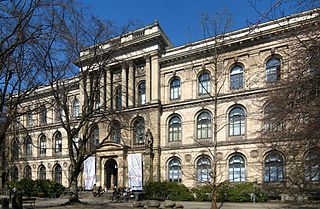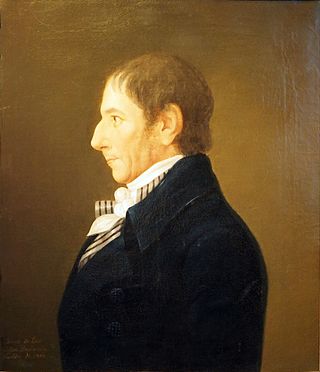
Technische Universität Berlin is a public research university located in Berlin, Germany. It was the first German university to adopt the name "Technische Universität".

Christian Gottfried Ehrenberg was a German naturalist, zoologist, botanist, comparative anatomist, geologist, and microscopist. He is considered to be one of the most famous and productive scientists of his time.

The Humboldt University of Berlin is a public research university in the central borough of Mitte in Berlin, Germany.

The Natural History Museum is a natural history museum located in Berlin, Germany. It exhibits a vast range of specimens from various segments of natural history and in such domain it is one of three major museums in Germany alongside Naturmuseum Senckenberg in Frankfurt and Museum Koenig in Bonn.

The University of Music and Theatre "Felix Mendelssohn Bartholdy" Leipzig is a public university in Leipzig, Saxony, Germany. Founded in 1843 by Felix Mendelssohn as the Conservatorium der Musik, it is the oldest university school of music in Germany.

Karl Asmund Rudolphi was a Swedish-born German naturalist, who is credited with being the "father of helminthology".

The Technische Universität Bergakademie Freiberg is a public university of technology with 3,471 students in the city of Freiberg, Saxony, Germany. The university's focuses are exploration, mining & extraction, processing, and recycling of natural resources & scrap, as well as developing new materials and researching renewable energies. It is highly specialized and proficient in these fields.

Albrecht Daniel Thaer was a German agronomist and a supporter of the humus theory for plant nutrition.

The Berlin-Brandenburg capital region is one of the most prolific centers of higher education and research in the world. It is the largest concentration of universities and colleges in Germany. The city has four public research universities and 27 private, professional and technical colleges (Hochschulen), offering a wide range of disciplines. Access to the German university system is tuition free.

Adolf Loewy was a German physiologist.

A Kunstgewerbeschule was a type of vocational arts school that existed in German-speaking countries from the mid-19th century. The term Werkkunstschule was also used for these schools. From the 1920s and after World War II, most of them either merged into universities or closed, although some continued until the 1970s.
Elisabet Boehm was a German feminist, writer, founder of the first Landwirtschaftlichen Hausfrauenvereins and the founder of the rural women's movement in general.
The Deutsche Hochschule für Politik (DHfP), or German Academy for Politics, was a private academy in Berlin, founded in October 1920. It was integrated into the Faculty for Foreign Studies of the Friedrich-Wilhelms-Universität in 1940, was re-founded in 1948 and turned into the Otto-Suhr-Institut of the Freie Universität Berlin in 1959.

Eberhard Fraas was a German scientist, geologist and paleontologist. He worked as a curator at the Stuttgarter Naturaliensammlung and discovered the dinosaurs of the Tendaguru formation in then German East Africa. The dinosaur Efraasia is named after him.
Rudolf Mansfeld was a German botanist and agricultural scientist.
Heinrich Friedrich Franz Körte was a German natural and agricultural scientist, and for thirty years Professor of Natural Sciences at the Agricultural Academy in Möglin, which was founded by Albrecht Daniel Thaer.
Paul Hermann Otto Eggert was a German surveyor and professor of Gdańsk University of Technology. He was also dean of the Faculty of Civil Engineering from 1909 to 1910 and from 1919 to 1920 and the first head of the Department of Geodesy at the Gdańsk University of Technology (1904-1921).

Carl Heinrich Hagen was a jurist, socio-economist and, between 1811 and 1835, senior government official (Regierungsrat). From 1811 he was also a professor of jurisprudence and the University of Königsberg in what was at that time East Prussia.

The Dahlem Manor is an open-air museum for agriculture and food culture in southwestern Berlin. It is the historical manor of the former village of Dahlem. The manor has been in service for over 800 years.

Silvia Hildegard Haneklaus is a German agricultural scientist and researcher specialised in Plant nutrition and Soil science.
















